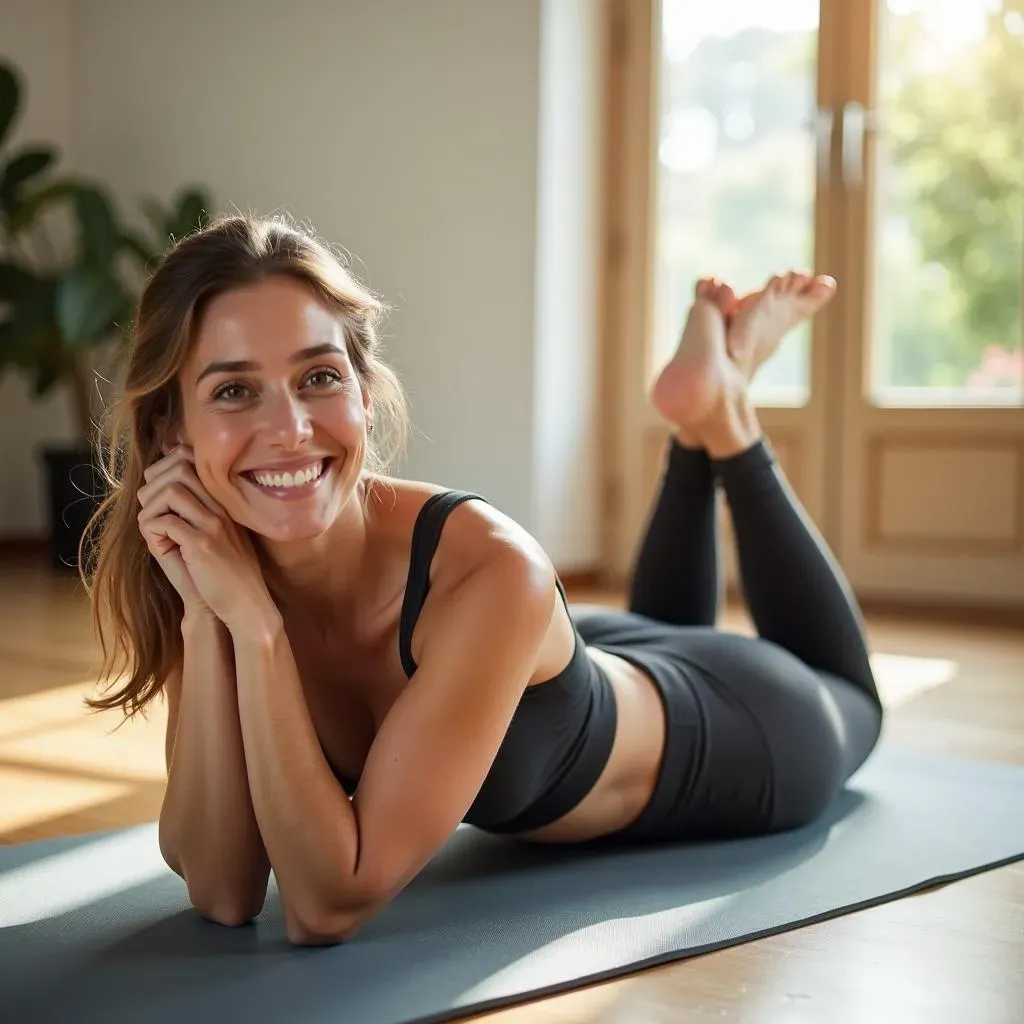Table of Contents
Is lower back pain keeping you from living your best life? You're not alone! Millions struggle with this common problem, but there's a powerful solution you can access anytime, anywhere: a pilates workout at home for lower back pain. This article isn't just another generic fitness guide; it's your personalized roadmap to a stronger, healthier back. We'll unpack the science behind lower back pain, showing you exactly why Pilates is so effective. Then, we'll dive into a series of easy-to-follow, at-home exercises designed to target the specific muscles that support your spine. Forget complicated equipment or expensive gym memberships – everything you need is right within reach. We'll also help you build a sustainable routine, so you can maintain a pain-free back long-term. Get ready to say goodbye to nagging aches and hello to a stronger, more flexible you! Let's get started on your journey to a healthier back.
Understanding Lower Back Pain and Pilates

Understanding Lower Back Pain and Pilates
Lower back pain? Ugh, been there! It’s incredibly common, often stemming from weak core muscles, poor posture, or even just sitting too long. Think of your core as the body's natural corset – it supports your spine and keeps everything aligned. When it's weak, your back takes the brunt of the strain, leading to aches and stiffness. That's where Pilates comes in. It's not just about crunches; it's a system of exercises focusing on precise movements, core engagement, and controlled breathing. Pilates helps build a strong, stable core, improving posture and reducing strain on your lower back. It's like giving your back the ultimate support system, strengthening the muscles that protect your spine. This isn't just about quick fixes; we're talking about building long-term strength and stability.
Pilates is all about mindful movement. It emphasizes quality over quantity, focusing on proper form to maximize results and minimize the risk of injury. You'll learn to engage your deep core muscles, which are often neglected in other workout routines. This targeted approach strengthens the muscles that truly support your back, preventing future pain and improving your overall posture. And the best part? You can do it all from the comfort of your home. No fancy equipment needed! If you're a complete beginner, check out our beginner Pilates workout to get started.
Problem | Pilates Solution |
|---|---|
Weak core muscles | Core strengthening exercises |
Poor posture | Improved body alignment and awareness |
Muscle imbalances | Targeted exercises to strengthen weak areas |
Many people find that adding a Pilates routine to their lives helps prevent back pain before it even starts. It’s a preventative measure as much as a treatment. Think of it as building a strong foundation for your body. A strong core improves your balance, too, reducing the risk of falls and further back injuries. For those looking to target their abs while improving back health, a Pilates workout for abs might be a good addition to your routine.
Before you begin any new exercise routine, it's always a good idea to chat with your doctor or a physical therapist, especially if you have pre-existing conditions. They can help you determine the best approach for your individual needs and ensure you're exercising safely. Remember, consistency is key. Even short, regular Pilates sessions can make a significant difference over time. You don’t need hours each day, just a focused, consistent approach. A quick Pilates workout can be surprisingly effective!
- Consult your doctor before starting any new exercise program.
- Focus on proper form and technique over speed.
- Listen to your body and rest when needed.
Effective Pilates Exercises for Your Lower Back at Home

Effective Pilates Exercises for Your Lower Back at Home
Let's get into some specific exercises! The beauty of Pilates is its adaptability. You can modify these moves to suit your fitness level. Remember, quality over quantity – focus on proper form to get the most benefit and avoid injury. A great starting point, especially if you’re new to Pilates, is our guide on beginner Pilates workouts. Start slowly and gradually increase the number of repetitions as you get stronger.
Here are three fantastic exercises to begin with: The Pelvic Tilt, the Bridge, and the Cat-Cow. The Pelvic Tilt strengthens your lower back and abdominal muscles, improving your posture. The Bridge strengthens your glutes and hamstrings, which are crucial for supporting your lower back. And the Cat-Cow improves spinal mobility and flexibility. These are just the beginning, of course! We'll be adding more exercises in the next section. For a more comprehensive approach to toning, consider our Pilates workout for toning routine.
- Pelvic Tilt: Lie on your back with knees bent and feet flat. Gently tilt your pelvis, pressing your lower back into the floor, then arching it slightly. Repeat 10-15 times.
- Bridge: Lie on your back with knees bent and feet flat. Lift your hips off the floor, squeezing your glutes. Hold for a few seconds, then lower. Repeat 10-15 times.
- Cat-Cow: Start on your hands and knees. Inhale, arch your back like a cat. Exhale, round your spine like a cow. Repeat 10-15 times.
Remember that consistency is key! Aim for at least 15-20 minutes of Pilates exercise, 3-4 times a week. Even a short, effective session can make a big difference in your lower back health. If you're short on time, try our quick Pilates workout routine. It's designed to give you a great workout in just a few minutes!
Don't forget to listen to your body! If you experience any pain, stop the exercise and consult a doctor or physical therapist. Pilates should feel challenging but never painful. If you’re looking for a more focused core workout, you might enjoy our Pilates workout for core strength. Building core strength is an important part of improving your lower back health.
Exercise | Focus | Benefits |
|---|---|---|
Pelvic Tilt | Lower back, abs | Posture, stability |
Bridge | Glutes, hamstrings | Lower back support, strength |
Cat-Cow | Spine mobility | Flexibility, pain relief |
Creating a Sustainable Pilates Routine for LongTerm Lower Back Health

Creating a Sustainable Pilates Routine for LongTerm Lower Back Health
Building Your Pilates Practice
So, you've experienced the benefits of Pilates for your lower back. Fantastic! Now, let's talk about making it a lasting habit, not just a quick fix. Consistency is key, but it's not about grueling workouts. Think small, achievable goals. Start with just 10-15 minutes, 2-3 times a week. Find a time of day that works best for you – maybe right after breakfast or before bed. The key is to make it a regular part of your routine, like brushing your teeth. If you're unsure where to start, our beginner Pilates guide can provide a great foundation. Remember, even short sessions are better than none!
Listen to your body. Don't push yourself too hard, especially when starting. Pain is a warning sign; it's not a badge of honor. Modify exercises as needed; there's no shame in using a chair for support or reducing the number of repetitions. The goal is to build strength and flexibility gradually, without causing injury. And remember, it's okay to take rest days! Your body needs time to recover and rebuild. For a more relaxed approach, check out our Pilates for relaxation guide. Rest and recovery are just as important as the workouts themselves.
- Start slow and gradually increase duration and intensity.
- Listen to your body and rest when needed.
- Focus on proper form over speed or repetitions.
Maintaining Long-Term Back Health
Once you’ve established a consistent Pilates routine, the real work begins: making it a lifelong commitment. This isn't just about avoiding pain; it's about building a strong, resilient body that can handle the demands of daily life. Think of it as an investment in your future self. Incorporate Pilates into your lifestyle, making it a non-negotiable part of your wellness plan. Remember that consistency is key – even short, regular sessions are far more effective than sporadic, intense workouts. A 20-minute Pilates session can be surprisingly effective!
Beyond the exercises themselves, consider incorporating other healthy habits into your lifestyle. Maintain good posture throughout the day, whether you're sitting at a desk, standing in line, or walking down the street. Stay hydrated, eat a balanced diet, and get enough sleep. These seemingly small changes can significantly impact your back health. If you're looking for ways to improve your posture, try our Pilates workout for posture routine. Good posture is a major contributor to lower back health.
Healthy Habit | Benefit |
|---|---|
Consistent Pilates | Stronger core, improved posture |
Good posture | Reduced strain on the spine |
Balanced diet | Provides nutrients for muscle repair |
Adequate sleep | Allows for muscle recovery |
